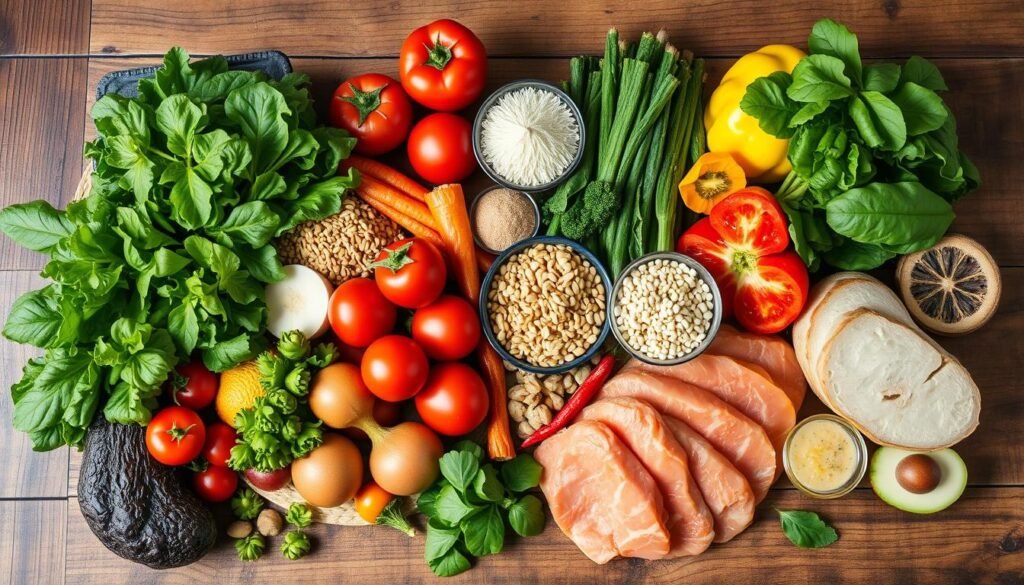About 17.9 million people in the U.S., aged 40 and up, have Peripheral Artery Disease (PAD). This condition cuts down blood flow to your limbs. It shows how vital nutritional tips for improving leg health are. Eating right plays a big role in keeping your legs in good shape, affecting how you move and feel overall.
For better leg function, it’s key to eat foods that build strong, healthy legs. Things like calcium, omega-3 fatty acids, and various vitamins are super important. Eating the best foods for strong legs does more than build muscle. It also boosts blood flow. This is a big deal for stopping PAD in its tracks.
Leafy greens full of Vitamin K and protein-rich foods are great for your legs. They help muscles repair and blood circulate better. This piece will show you the key nutrients and foods for robust legs and smooth circulation. Let’s look at why nutrition is so important for your leg’s health.
Key Takeaways
- Nutrition greatly affects leg health, how we move, and our general wellness.
- Calcium, omega-3s, and vitamins are vital for keeping legs strong.
- Eating greens helps blood move well and muscles work better.
- Drinking plenty of water is crucial for good blood flow and leg health.
- Making changes to your diet can prevent PAD and other issues.
Understanding Leg Health and Nutrition
Leg health is very important for moving around easily and enjoying life. It involves having strong muscles, stable joints, and good blood flow. These things help us stay active and do everyday tasks. Eating right helps keep our legs strong and our joints healthy. So, nutrition is key for anyone wanting to keep their legs in top shape.
Not eating well can cause joint pain, tiredness, and weak muscles. We need vitamins, minerals, and other nutrients for our legs to work well. Protein helps build muscles, and calcium and vitamin D make our bones strong. Not getting enough of these can slow down recovery after exercise and make performance worse. This shows how important a balanced diet is.
Good circulation is also essential for leg health. Poor blood flow can cause symptoms like blood pooling and leg discoloration. Eating foods rich in antioxidants and avoiding inflammatory foods can boost circulation. This helps lower the risk of varicose veins and deep vein thrombosis.
By choosing balanced meals and making healthy life choices, we lay the groundwork for healthy legs. Leg health nutrition urges us to eat different food groups. We should include lean proteins, whole grains, fruits, and veggies to get the nutrients we need.
Taking a well-rounded approach that includes diet, exercise, and positive lifestyle changes promotes lasting leg health. It also improves our overall health.
The Importance of Nutritional Tips for Improving Leg Health
Nutritional tips are key for better leg health. They boost leg strength, performance, and recovery. A good diet helps muscles and reduces fatigue and weakness. It also fights inflammation, which affects joints and muscles. Good eating habits keep you active.
Poor blood flow in legs can cause numbness, cramps, and swelling. It’s important to eat foods rich in antioxidants, fiber, and healthy fats. Avoid too much saturated fat and salt. Add more monounsaturated and polyunsaturated fats. Fish is great for the heart and blood vessels. Nutrient-rich meals improve circulation.
Staying hydrated is crucial for blood flow. Drinking eight glasses of water daily helps the circulatory system. Exercise and yoga boost circulation too. Following these leg health tips improves blood flow and leg health.
Understanding nutrition can boost leg health and recovery. A tailored nutritional plan makes a big difference for healthy legs.
| Element | Importance |
|---|---|
| Hydration | Maintains proper circulation and overall health. |
| Antioxidants | Reduces inflammation and supports muscle recovery. |
| Healthy Fats | Improves heart health and blood circulation. |
| Protein | Essential for muscle repair and growth post-exercise. |
| Vitamins and Minerals | Supports overall leg health and improves recovery. |
Essential Nutrients for Leg Health
To keep your legs healthy, you need to know about some key nutrients. These nutrients are important for strong bones, well-working muscles, and good blood flow. They affect your everyday activities and your performance in sports.
Calcium is really important for adults, who should get about 700mg every day. It makes bones strong and helps legs stay stable, cutting down on the chance of breaks. People, especially those going through menopause, need to make sure they get enough calcium to keep their legs healthy.
Vitamin D helps your body use calcium better. Adults need around 10 micrograms (400 IU) of it each day. In the winter, or if you’re not getting enough, consider taking a supplement. To stay healthy, eat foods with vitamin D like fatty fish or fortified options.
Omega-3 fatty acids help fight inflammation. They are in fatty fish like salmon and help blood flow better. This keeps your blood vessels healthy and can help if your legs often feel uncomfortable due to poor circulation.
Protein helps fix and strengthen muscles. Getting enough protein helps you move better, which is great if you’re active. Eating beans, nuts, and quality meats will help you get the protein you need.

Not getting enough of these important nutrients can hurt your leg health and make moving around harder. Eating a mix of vitamins and minerals is key. A good diet means better activity and health overall.
Best Foods for Strong Legs
To build strong legs, you need a diet full of nutrients. Certain foods are known for making muscles stronger. By eating the best foods for strong legs, you can grow your muscles while staying healthy.
Calcium-Rich Foods and Their Benefits
Calcium is crucial for keeping bones strong, which helps with movement and leg strength. You can find lots of calcium in dairy like milk, yogurt, and cheese. If you don’t eat dairy, try fortified almond or soy milk instead. These options also give you vitamin B12 and magnesium, which help muscles and nerves.
Omega-3 Fatty Acids and Their Role in Leg Health
Omega-3 fatty acids lower inflammation in joints and muscles. Foods rich in omega-3s, like salmon, mackerel, walnuts, chia, and flax, are good for your legs. Studies say these foods make your legs work better and can reduce the chances of chronic pain. Eating omega-3s is a good way to make your legs stronger and more enduring.

| Food Item | Protein Content (grams per serving) | Key Nutrients |
|---|---|---|
| Chicken Breast (100g) | 31 | Protein, B Vitamins |
| Salmon (100g) | 20 | Omega-3, Protein |
| Greek Yogurt (1 cup) | 20 | Protein, Probiotics |
| Tuna (3 oz) | 20 | Omega-3, Protein |
| Eggs (1 large) | 7 | Complete Protein |
| Sunflower Seeds (1 oz) | 23 | Vitamin E, Healthy Fats |
| Lean Beef (100g) | 26 | Iron, Protein |
| Shrimp (100g) | 24 | Protein, Low Calories |
To make your legs stronger, it’s not just about eating different foods. You also need to understand how each food helps your muscles. With the right foods, your legs can perform better and recover faster. For tips on boosting leg muscle strength, check this resource.
Foods for Better Circulation in Legs
Eating the right foods is key to improving leg circulation. It can boost blood flow and keep your vascular health strong. Here are some foods to help with circulation.
Fruits and Vegetables that Promote Circulation
Some fruits and vegetables are great for circulation. Leafy greens like spinach have nitrates to open blood vessels. This improves circulation. Berries, including blueberries and strawberries, are not just tasty. They have antioxidants to lower blood pressure and make arteries flexible. Like oranges, rich in vitamin C, they strengthen vessel walls and reduce inflammation. Eating these regularly supports better circulation in the legs.
Leg Strengthening Foods to Include in Your Diet
Certain foods for better circulation in legs also boost muscle and endurance. Lean proteins from chicken and turkey are crucial for muscle repair. They help with strength. Whole grains, such as quinoa and brown rice, give you long-lasting energy. This is important for staying active. Legumes like lentils and beans add protein and fiber to your diet. This supports circulation and muscle growth. Eating walnuts and fatty fish, such as salmon, is good for your heart. It also reduces inflammation, aiding circulation and leg strength.

Diet for Healthy Legs: What to Avoid
To keep your legs healthy, think about more than just eating right. It’s crucial to also know what not to eat. Some foods could cause inflammation or harm your legs over time. Here are the types of foods you should steer clear of to keep your legs strong and functional.
Inflammatory Foods That Harm Leg Health
Some foods cause inflammation, which is bad for your legs. The main ones to avoid include:
- Refined grains, like white bread and pastries
- Too much sugar, found in sodas and sweets
- Trans fats, in fried foods and baked snacks
These inflammatory foods that harm leg health can make joint pain worse. They can also slow down muscle recovery in your legs. Cutting back on these foods is important for stronger legs. Studies show making smart food choices is key for leg health.
Processed Foods to Limit for Better Nutrition
Processed foods are not great for your legs. They have bad fats, extra sugars, and preservatives. Eating too much of these foods can hurt your health. Here’s what to eat less of:
- Processed meats, like sausages and hot dogs
- Sweet snacks, including candy bars and pastries
- Canned soups and sauces, high in sodium
Eating more natural, nutrient-rich foods helps keep your legs healthy. Focus on whole foods for better nutrition and stronger legs.
Additional Leg Health Tips
Maintaining leg health takes a mix of good leg health tips and smart leg health nutrition. Exercise is key to keeping legs strong. It’s important to include both strength training and stretching exercises. This helps your legs stay stable and reduces injury risk. Drinking lots of water is important too. It keeps your muscles and joints in good shape.
It’s vital to avoid too much alcohol and smoking. These habits hurt your blood flow and can make leg problems worse. Getting enough sleep is also important. It helps your muscles recover and grow.
Walking, jogging, swimming, and yoga are great for improving circulation and leg strength. For people who stand a lot at work, like in beauty or nursing, wearing compression stockings helps a lot. They can relieve symptoms effectively. Below is a guide for choosing the right compression level:
| Compression Level | Recommended Use |
|---|---|
| 15-20 mmHg | For general use and some jobs |
| 20-30 mmHg | For managing leg symptoms |
Lifting your legs can help blood flow better. This can lessen swelling and tiredness. Getting massages can also help by boosting circulation and relaxing muscles. By following these tips regularly, you’ll see big improvements in how your legs look and feel. Keeping a healthy weight is part of this too. Check out these habits for more on keeping your legs healthy.
Conclusion
The journey to better leg health relies on good nutrition. By following the right dietary advice, people can get stronger, more flexible legs. Nutrients like Vitamin E and C are key to avoiding blood clots and making blood vessels stronger.
Eating foods rich in magnesium and Omega-3s is also great for your legs. They help with blood flow and circulation. Plus, a balanced diet and regular exercise work together for your health.
Activities like a short daily walk make a big difference in blood flow. This is especially true for those with peripheral artery disease. Also, drinks like green tea and beetroot juice are good for your legs.
To see the best results, talk to a healthcare expert. They can offer advice tailored to your needs. Making these changes can improve leg health and boost your overall well-being. For more tips on how nutrients impact energy and health, read this detailed article on essential nutrients for energy.